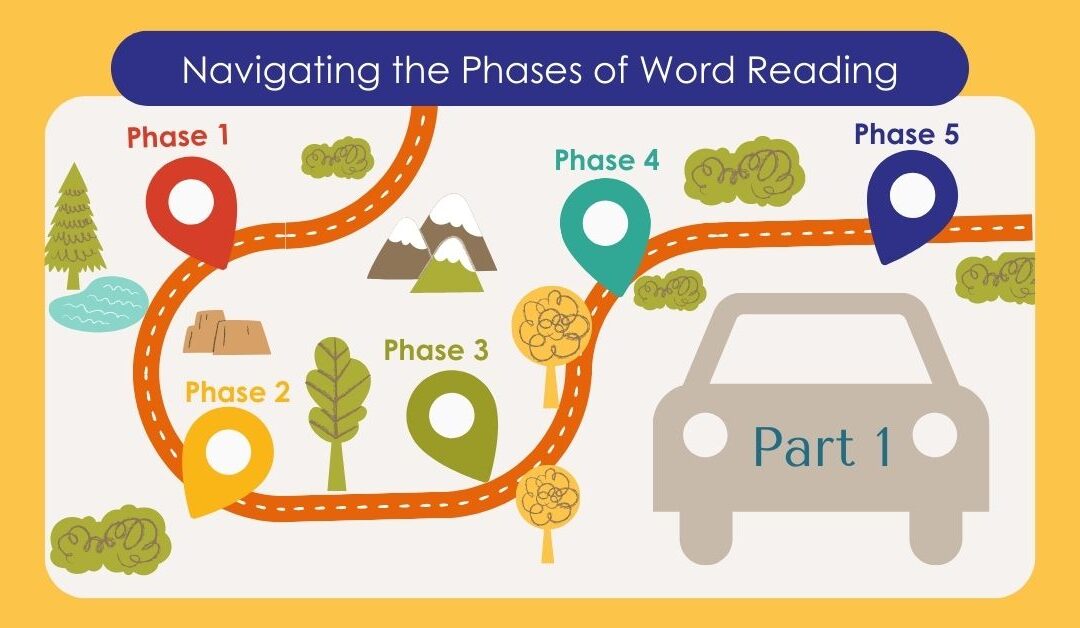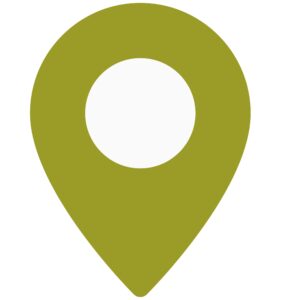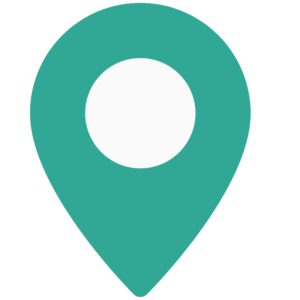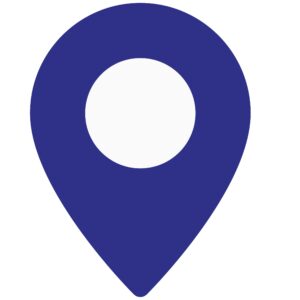It is summer! Perhaps you are traveling somewhere. While you probably rely on the little person inside your phone to tell you which way to go, we want you to think about how you navigate using a paper map–you know, like in the old days!
In preparation for an upcoming blog series about why some traditional reading prompts are problematic, we’ve decided to take a road trip into the fascinating world of word reading, guided by the wisdom of Linnea Ehri. So, get ready to explore Ehri’s phases of word reading (1987, 1995, 2002, 2005, 2017) and discover how understanding these phases can help you guide young readers to more accurate, efficient, and rewarding reading experiences.
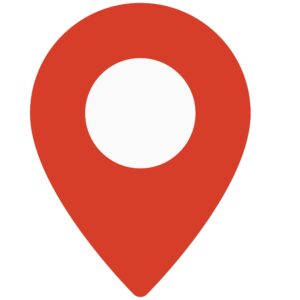 Phase 1: The Pre-Alphabetic Stage
Phase 1: The Pre-Alphabetic Stage
(Relying on Landmarks)
Picture a group of wide-eyed learners not yet making sense of the written word. During this pre-alphabetic stage, children rely on visual cues, like logos and pictures, to “read” words. They’re newbie map readers, only understanding that those squiggly marks tell them something relevant to the context. They rely on landmarks surrounding the print to find their way. They see the iconic red concentric circles and call out, “Let’s go to Target!” This phase of word “reading” is fun, easy, and even game-like. Think of this as the beginning reader’s relying-on-landmarks phase!
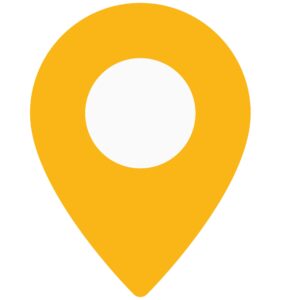
Phase 2: The Partial Alphabetic Stage
(Playing With Maps)
In this phase, budding readers have begun to notice others using maps and are starting to show an interest in developing their own map-reading skills. They’re developing knowledge of some letter names and sounds, but their understandings of how print actually works are rudimentary, at best. They may still rely on some textual “landmarks,” but they are paying a new level of attention to some known letters, especially at the beginnings of words. They see a sign for Bridgeport and say, “Hey, it has a B, like my sister Bridget’s name!” because they combine some print clues and some contextual clues to “read” some words. “Hey, look! Burger King and Bridget! They both have the same letter!” Yet despite spotty success, they’re very selective about the few letters they do attend to and often mis ”read” words. They only understand how bits and pieces of the alphabetic system work, so they still can’t truly find their way through the words on the page. Think of this as their playing-with-maps phase.
Phase 3: The Full Alphabetic Phase
(Realizing the Power of Maps)
As they enter this phase, our young navigators truly understand how to find their way through the written words, not around them! They’ve figured out the relationship between sounds and spellings! They are careful and conscious as they work across words. They encounter a signpost for the city of Kent and know they must use all of the available print to figure out exactly what the sign says; the first letter or a few known letters alone will not do it. They know that the spellings on the sign represent the spoken sounds in the word and that these sounds and spellings align in precise ways.
This understanding is referred to as the alphabetic principle, and it is the compass for their travels through words. Although they enter this phase with very incomplete knowledge of orthography, as they travel, they learn more and more about sound-spellings – both through explicit instruction and through practice – and store this knowledge in their brains in organized ways so that they can find it when they need it. When it comes to reading a map, this is the equivalent of really understanding how it works, from the key to grids, to the little airplane icons that represent an airport.
In this phase, however, readers don’t travel at top speed while listening to music and chatting with friends. In fact, much of the navigation at this stage requires slow, arduous, and intentional map study. These navigators know how a map works, but they just aren’t automatic enough to read it quickly. When it comes to reading words, these readers rely heavily on decoding and blending sound-by-sound to come up with a word that is close enough to a word they know. “/K/-/e/-/n/-/t/. Kent!” They still use their surroundings and landmarks to help them at times, but only to confirm that they are on the right path or that they have arrived–not as the main navigational strategy. This phase is hard work! But it’s an empowering and important stage where the written word begins to take readers to exciting places, even though they still aren’t fluent in map reading, and may take a bit longer to get from Point A to Point B.
But the more experience they get with maps, the more efficient they become and the more knowledge they collect about how maps (the alphabetic system) work. If they don’t put on lots of miles, processing lots of sound-spellings along the way, then they will be forced to always rely on landmarks and less reliable clues. Think of this as the realizing-the-power-of-maps phase.
Phase 4: The Consolidated Phase
(Becoming Confident with Maps)
Ah, the consolidated phase! As readers consolidate their knowledge of how maps work, they no longer need to study each word slowly every time they travel through a text. They’ve got muscle memory for how to use the map, and they have consolidated information about how the map relates to their knowledge of directions, street grids, and interstate numbers, etc. In this phase, they move down the road more efficiently because they can recognize so many words and word parts quickly. They don’t rely on sound-by-sound decoding nearly as much because they have put on so many miles, learning the lay of the land of English orthography. They know lots about which sound-spellings typically go together, which ones don’t, and how combinations of those sounds often work together to form recognizable word parts. These readers don’t need to work out the word Burlington sound-by-sound. When they see it, they recognize parts and say, “This looks familiar!” So they have already learned the route through some of the chunks of this unfamiliar word, “/Bur/ – /ling/ – /ton/. We are going to Burlington!” Think of this as the becoming-confident-with-maps-phase.
Phase 5: The Automatic Phase
(Traveling With Ease)
In the final phase of word reading, the one that you are most likely in, explorers are operating off their vast experiences with all kinds of trails, paths, and roadways. In this phase, the travel is easy. Very little decoding – or arduous map reading – is required at all. And because decoding is no longer a burden on their attention, they can travel more efficiently and extensively, with more energy available to simply enjoy the journey rather than needing to laboriously focus on the map. This carefree stage of travel frees them up to notice more about the terrain and the scenery they are crossing. It allows them to be more inquisitive and reflective about what they are experiencing on their travels. In the automatic phase, they continue to expand their vocabulary, deepen their comprehension, and develop a lifelong love for the journey of reading–the reward that has been their destination all along. Think of this final phase as the traveling-with-ease phase.
So now you know some things about Ehri’s phases of word reading. As you embark on this word reading journey with your young learners, you are their trusted guide, setting them up for reading success and encouraging them every step of the way.
Remember, each child progresses through these phases at their own pace, and the boundaries between each phase might be a bit blurry. Explorers often spend time in two or more phases simultaneously, depending on the demands of the navigation (text).
And even though most children will begin their journey into print by spending some time in the pre-alphabetic phase (looking-for-landmarks) and the partial-alphabetic phase (playing-with-maps), we don’t want to encourage or extend the time children spend there. These are inefficient phases that compensate for incomplete understandings of what print navigation really entails.
Instead, when guiding beginning print explorers, we want to steer them into the full-alphabetic (becoming-confident) and eventually the consolidated (traveling-with-ease) phases. We can do this with both our instruction and our careful selection of texts that align with their current navigation skills.
Where are your students on this path to learning to navigate print? How will you encourage them to stick with the hard work of learning to really understand the alphabetic map of written English?
With this introduction to the phases that all readers work through on the path to fluent word reading, we will dedicate a few future posts to examining some of the prompts that we have relied on in the past to help children to figure out words — think “Eagle Eye” (looking at the pictures) and “Skippy the Frog” (skipping over words) — through the lens of Ehri’s phases.
We hope you’ll decide to stay with us on this journey. Until then, traveling mercies, friends.
References
Ehri, Linnea C. 1995. “Phases of Development in Learning to Read Words by Sight.” Journal of Research in Reading Research 18 (2): 116-125.
Ehri, Linnea C. 2005a. “Learning to Read Words: Theory, Findings, and Issues.” Scientific Studies of Reading, 9 (2): 167–188. doi: 10.1207/s1532799xssr0902_4
Ehri, Linnea C. 2005b. “Development of Sight Word Reading: Phases and Findings.” In M. J. Snowling and C. Hume (Eds.), The Science of Reading: A Handbook (pp. 135–154). Oxford, UK: Blackwell.
Ehri, Linnea C. 2017. “Orthographic Mapping and Literacy Development Revisited.” In Theories of Reading Development, ed. K. Cain, D. L. Compton, and R. K. Parrila (pp. 169-190). Amsterdam, The Netherlands: John Bejamins, doi: 10.1075/swll.15.08ehr.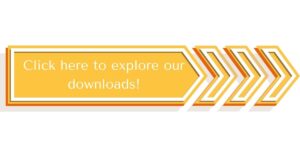
Explore the whole blog series:
Showing Young Readers How to Navigate the Phases of Word Reading
Part 1: A Journey Through Ehri’s Phases
Part 2: Why Looking at the Pictures Isn’t as Helpful as We Thought
Part 3: Why Looking at the First Letter of the Word Isn’t Enough
Part 4: Problems With Skipping Words
Part 5: The Downsides of Asking Children to Search for Chunks in Words
Part 6: The Power of Teaching Students to Blend Words
BONUS: The Power of Teaching Readers to Try Alternate Sounds

